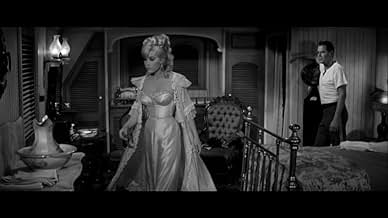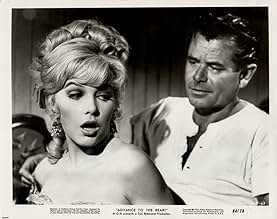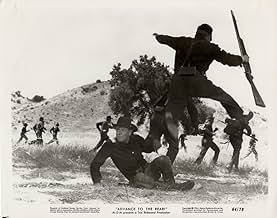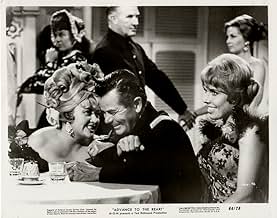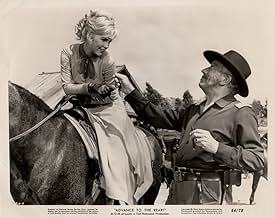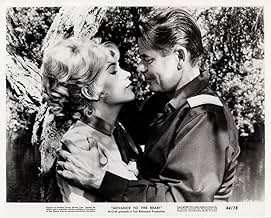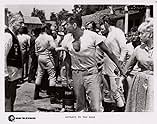AVALIAÇÃO DA IMDb
5,9/10
928
SUA AVALIAÇÃO
Adicionar um enredo no seu idiomaWhen A Union Army outfit of misfits and rejects is sent to the Western territory, Southern spies try to figure out what they're doing there.When A Union Army outfit of misfits and rejects is sent to the Western territory, Southern spies try to figure out what they're doing there.When A Union Army outfit of misfits and rejects is sent to the Western territory, Southern spies try to figure out what they're doing there.
Alan Hale Jr.
- Sergeant Davis
- (as Alan Hale)
Richard Adams
- Courier
- (não creditado)
Leon Alton
- Waiter
- (não creditado)
Robert Anderson
- Steamboat Captain
- (não creditado)
Ann Blake
- Member of the Law & Order League
- (não creditado)
Danny Borzage
- Trooper
- (não creditado)
Enredo
Você sabia?
- CuriosidadesThe steamboat used in this movie was originally built and used as the Cotton Blossom, in MGM's O Barco das Ilusões (1951). It was also used in A Árvore da Vida (1957) and As Aventuras de Huckleberry Finn (1960). In the 1970s, it was one of the props auctioned off by the studio.
- Erros de gravaçãoIn the scenes where the cannons fire 30 rounds, some of the cannons fire before their fuses are ignited.
- Citações
Martha Lou: All right. Let's say, just for the moment, that I *am* a spy.
Heath: A very pretty one, too.
Martha Lou: That would make us enemies, Jared.
Heath: Yeah, of course it would. And, we'd be starting out at a point in marriage that takes some couples twenty or thirty years to achieve!
Avaliação em destaque
I have just finished reading Jack Schaefer's book, "Company of Cowards", and by coincidence, I watched this film on TCM this morning. I have to say that, apart from the names of some of the characters, this film bears very little resemblance to the book. For example, in the film, the character of Hugo Zattig, is a villainous and duplicitous, Confederate officer, played by James Griffith. In the book, the character is one of the "Company of Cowards", whose honour is redeemed at the end of the book.
Technically, the book was a historical novel, centred around the fictional character of Jared Heath, himself a disgraced Union officer, busted to sergeant, who was detailed to take charge of a company of other disgraced officers who had also been demoted for crimes such as desertion, disobedience, brawling and other such offences that are not tolerated in any Army, past or present. The end of the novel describes how Jared Heath and his "Company of Cowards" manage to redeem themselves during a heroic battle against Comanche and the Kiowa Indians, with a few of them giving their own lives in the heat of battle.
I should imagine that the producers and MGM had a lot of debate about how this film should be made. Was it to be a film about the true horrors of war and how disgraced soldiers were treated by the other troopers, as depicted in the novel? No, it was to be made as a knockabout comedy, directed by George Marshall, who had already directed James Stewart in "Destry Rides Again" and Glen Ford in a few other films, such as another comedy western, "The Sheepman".
A question had already asked as to whether the television comedy series, "F Troop" was loosely based on this film. Well, as the series was released on ABC a year later, it is probably more than a coincidence that the producers of the series did take some inspiration from this film. Ken Berry would have been a more naïve version of the Glen Ford character.
Jack Schaefer's novel was a very serious study on how the American Civil War was fought, which went on to describe the horror of fighting in the Indians Wars, when many hostile Indian tribes took advantage of the fact that the "white men" were distracted with fighting each other.
There were also some political comments about why the Union government kept changing its mind as to the reason for the war, starting out with political wrangles about why the Federal Government should have control over the distant Southern States; with the economic disparity between the Southern States and the Northern States; the need to keep the Union together; and, finally, the Abolition of Slavery.
Jack Schaefer wrote "Shane", one of the greatest and most realistic westerns ever written and filmed - I wonder what he thought of how his original novel was brought to the screen.
I will give the film 8 out of 10 for the lively performances of Glen Ford and the lovely Stella Stevens.
Technically, the book was a historical novel, centred around the fictional character of Jared Heath, himself a disgraced Union officer, busted to sergeant, who was detailed to take charge of a company of other disgraced officers who had also been demoted for crimes such as desertion, disobedience, brawling and other such offences that are not tolerated in any Army, past or present. The end of the novel describes how Jared Heath and his "Company of Cowards" manage to redeem themselves during a heroic battle against Comanche and the Kiowa Indians, with a few of them giving their own lives in the heat of battle.
I should imagine that the producers and MGM had a lot of debate about how this film should be made. Was it to be a film about the true horrors of war and how disgraced soldiers were treated by the other troopers, as depicted in the novel? No, it was to be made as a knockabout comedy, directed by George Marshall, who had already directed James Stewart in "Destry Rides Again" and Glen Ford in a few other films, such as another comedy western, "The Sheepman".
A question had already asked as to whether the television comedy series, "F Troop" was loosely based on this film. Well, as the series was released on ABC a year later, it is probably more than a coincidence that the producers of the series did take some inspiration from this film. Ken Berry would have been a more naïve version of the Glen Ford character.
Jack Schaefer's novel was a very serious study on how the American Civil War was fought, which went on to describe the horror of fighting in the Indians Wars, when many hostile Indian tribes took advantage of the fact that the "white men" were distracted with fighting each other.
There were also some political comments about why the Union government kept changing its mind as to the reason for the war, starting out with political wrangles about why the Federal Government should have control over the distant Southern States; with the economic disparity between the Southern States and the Northern States; the need to keep the Union together; and, finally, the Abolition of Slavery.
Jack Schaefer wrote "Shane", one of the greatest and most realistic westerns ever written and filmed - I wonder what he thought of how his original novel was brought to the screen.
I will give the film 8 out of 10 for the lively performances of Glen Ford and the lovely Stella Stevens.
- andyrobert
- 21 de jun. de 2021
- Link permanente
Principais escolhas
Faça login para avaliar e ver a lista de recomendações personalizadas
- How long is Advance to the Rear?Fornecido pela Alexa
Detalhes
- Tempo de duração1 hora 40 minutos
- Cor
- Proporção
- 2.35 : 1
Contribua para esta página
Sugerir uma alteração ou adicionar conteúdo ausente

Principal brecha
By what name was Avance para a Retaguarda (1964) officially released in India in English?
Responda

